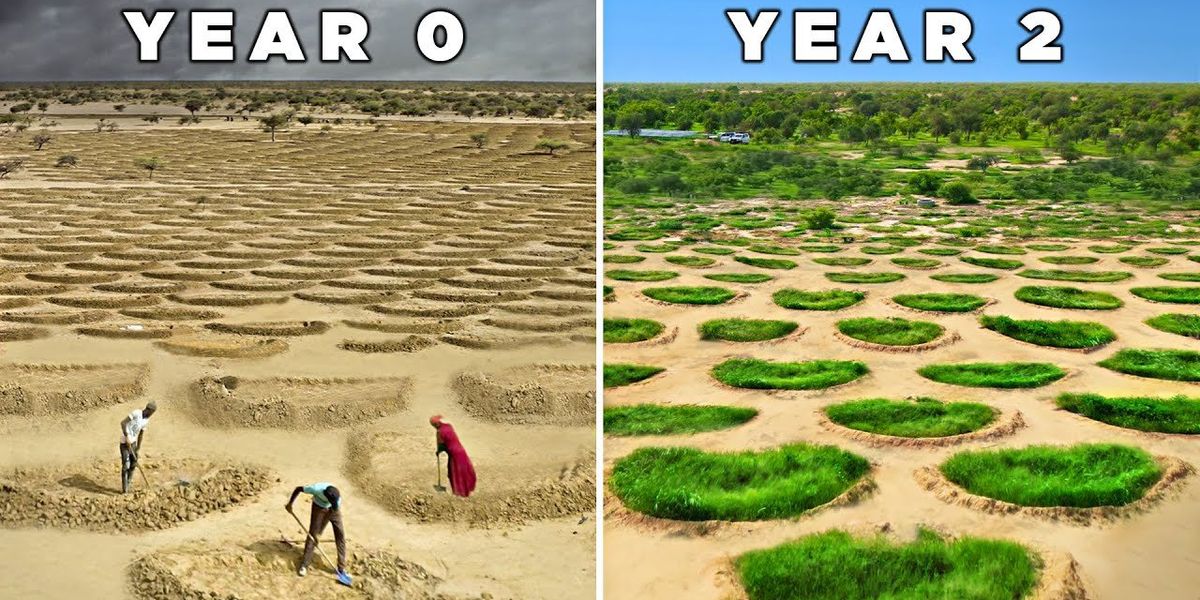Just a few years ago, the Sahel region at the northern edge of Senegal was a “barren wasteland” where nothing had grown for 40 years. But the United Nations World Food Programme (WFP) and local villagers teamed up to regreen the area, bringing back agriculture, improving the economy of the people who live there, and preventing the climate migration that desertification ultimately leads to.



These are always only pilot projects with limited funding. And who do you think is more likely to maintain this infrastructure and proudly tell their neighbours about them so that they can replicate it? Surely not the person that is annoyed that some rich guy from the capital with a digger came and did all the work and took all the money that they would have happily earned. These largely subsistence communities are cash starved and projects like that are a welcome opportunity to earn some money on the side.
The difference in efficiency is so high, you could run through with the backhoe and then give locals the money anyway.
Community buy-in is more important than efficiency in projects like this.
Sure, these projects could be done more efficiently by one construction company with heavy machinery, but that takes dollars these dirt poor areas don’t have (and I think Trump’s bullshit arbitrary defunding of USAID is an object lesson for developing countries not to rely on foreign charity for anything important, among many, many other reasons why foreign charity is bad for development). So local people need to know how to do it with local resources in order to expand the projects to new areas.
Just as important, local communities need to support and maintain these projects in the long run, and sweat equity is a great way to build commitment.
Something along the lines of “hiring heavy equipment, then buying a ticket to the gym, everytime you need this done because you never learned anything else”. My neighbours tell me I need heavy equipment to fell my forest, absolutely not, I’ll go on foot, respect and fell every single tree I plan to fell, leave no tracks, become stronger and wiser, all for free.
Heavy equipment is not cheap, too, especially if you need an operator with skill comparable with attention to small details that manual laborers have naturally. And it does not spread virally like skills. And it burns carbon and leaves tracks. It has its uses at scale, but not in pilots. Same thing everywhere: I have a pick-and-place robot to assemble my electronics, not even turning it on before I have at least 100-ish boards to assemble; it’s not expensive, it’s easier than manual labor - but you’ve got to know the system you build before giving it away to a machine, or you’ll have a long and expensive debug session ahead of you, even if you are certain know everything about it, which is totally not the case here.
Oh no… tracks. In the barren wasteland. Where the whole point is creating divots for water.
You got a well-written, thoughtful and meaningful comment, and you mined it for one nitpick to sarcastically attack as if it was the whole point.
Pearls before swine.
It’s dissembling nonsense on every level. The first sentence doesn’t even parse. Half the comment is irrelevant self-congratulatory wank about trees and electronics. There’s about fifteen contiguous words that matter, at all, and they’re buried in the middle of three half-wrong sentences.
The scale of this “pilot” wasn’t one fucking hole. It’s acres of them. A single backhoe would still be busy for weeks.
I only picked one nit because it highlights the failure to recognize what matters, here. Tracks are not a negative. There’s no grass being torn up, like the nimble woodsman here seems to be picturing. It’s barren wasteland.
That picked nit, by the way, was a concise and impersonal rebuke of only that point. When I want to attack someone I am not fucking subtle. But thanks for dragging this all out, with your performative eye-rolling that contributes nothing but unpleasant disdain.
All three of the “sentences” in your reply don’t fucking parse if you want to be goddamn garmmar nazi about it.
It’s fragmentary delivery of one sentence which you plainly understood just fine.
Actual hypocrisy would be you mining a wide-ranging rebuke for that failed riposte.
It wasn’t hypocrisy, I was demonstrating a lack of respect for anything you had to say, just like you did. Doesn’t feel good, does it?